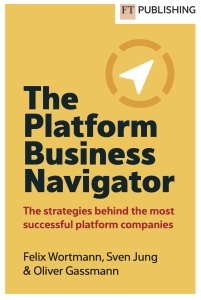The Platform Navigator
88 pattern cards to design and implement platform business models
Today, platform companies like Amazon, Alibaba, Apple and Google dominate our economy. However, it is not just about digital companies that have embarked on a platform journey. Platforms affect many traditional businesses and leveraging network effects will be vital for each and every company. By reviewing the most important literature and studying more than 150 cases, we have identified 88 patterns across five phases to design and implement platform business models. Not all patterns will be helpful for your business and the patterns are certainly not exhaustive. But we believe that every manager should be aware of them to sustain competitive advantage. Thus, the pattern cards will help you navigate through the Platform Economy.
What is it good for?

“There is a lot of literature on platform business models, but ‘The Platform Navigator’ is one of the most comprehensive and easy-to-understand guides with a clear structure and insightful examples. A must-read for any manager interested in the essentials of platform design, growth and management.”
Felicitas Geiss, Vice President Strategy & Venture Architecture at Azena
“Platform business models are very important for us at Bosch. Many of our projects and growth initiatives depend on network effects, which is often only apparent at a second glance. The well-researched collection of 88 patterns helps us in our daily work to identify those opportunities early on and gives us actionable support in developing viable platform business models.”
Stefan Ferber, Co-CEO & CTO at Bosch.IO

How to apply the navigator? The five phases.
I. Ideate: What opportunities exist?
We often see that companies start to develop a platform business model but have not fully understood the platform concept – not only from a conceptual point of view but also from a practical point of view. In essence, they are not aware of the diverse nature and mechanics of existing platforms. The patterns in this section serve as an inspiration and a starting point. Browse through the 21 patterns in seven distinct categories to get inspired and identify opportunities for your own business.

II. Design: How do we create value?
When embarking on a platform journey, you have to understand that there are two fundamentally different types of platforms. On the one side, there are transaction platforms, also known as marketplaces, where you have buyers and sellers (e.g., eBay) or providers and consumers (e.g., Airbnb). On the other side, there are innovation platforms like Amazon Web Services (AWS). AWS is a cloud platform that serves as a basis for others to innovate and develop applications on top. Designing transaction and innovation platforms requires different principles and choices. Use the 26 patterns to determine (A) the core value proposition, (B) the ownership model, and (C) the operating model for your transaction or innovation platform.

III. Monetize: How do we capture value?
In the long run, every business needs a solid monetization strategy to capture value. Platform businesses often defer monetization as it can severely harm network effects. Examples like YouTube or LinkedIn illustrate that it can even take decades until monetization. Nevertheless, most platforms have a rigid long-term strategy for monetization. Go through the 15 patterns including (A) direct monetization, (B) indirect monetization and (C) monetization tactics to discuss how you want to capture value.

IV. Scale: How do we grow?
Every platform business faces the famous chicken-and-egg problem. In the case of a new marketplace, for instance, no sellers mean no supply and hence no customer demand. No customers, on the other hand, mean no demand and hence no seller will engage in such a marketplace. Platforms must overcome this deadlock situation. Get inspired by 14 patterns in five categories that successful platforms have leveraged before to overcome the chicken-and-egg problem.

V. Manage: How do we manage?
These patterns include best practices to (A) innovate and (B) defend the platform core as well as to (C) maintain network effects. Besides concrete strategies, this phase also includes universal guidelines on how to (D) monitor performance. Use the 12 pattern cards to understand early on what will become important in your future platform journey.

How to bring everything together? The canvas.
The following canvas has proven to be very helpful in starting a platform project. As a supplement to the pattern cards, it can be used to capture the platform idea in a clear and structured manner.
The canvas builds upon traditional business model building blocks, such as value proposition (What do we offer?), value creation (How do we create value?) and value capturing (Why does it generate value?), but also integrates platform-specific components such as value flow, the chicken-and-egg problem and platform management. The canvas not only supports communication with your stakeholders but also helps discussing, testing, and refining the platform idea further, for example, with your customers and partners.



